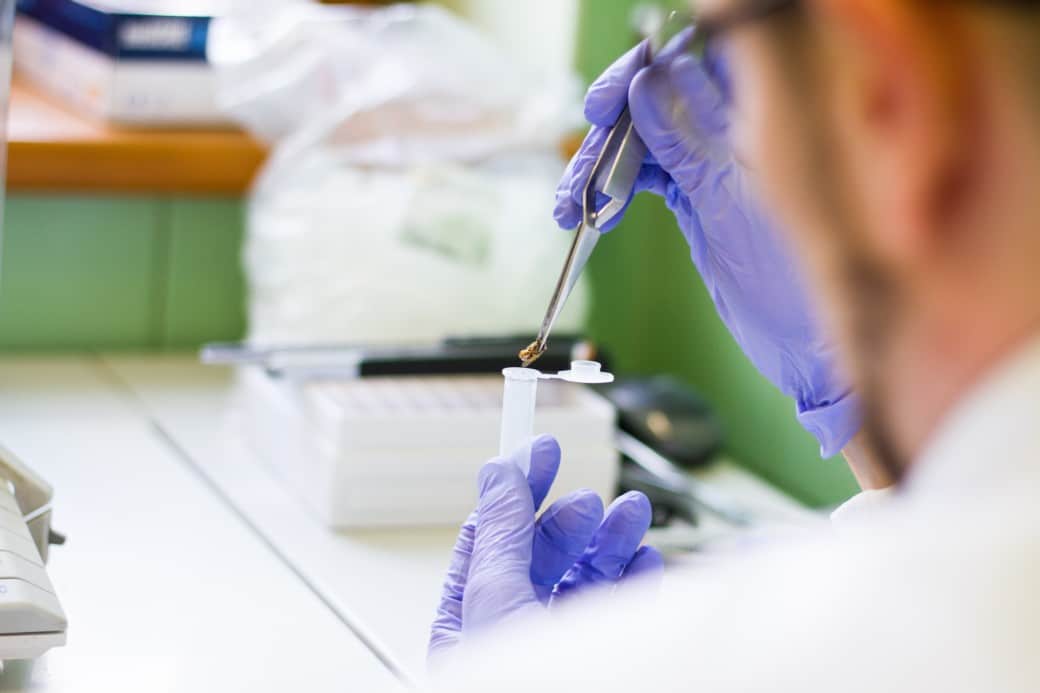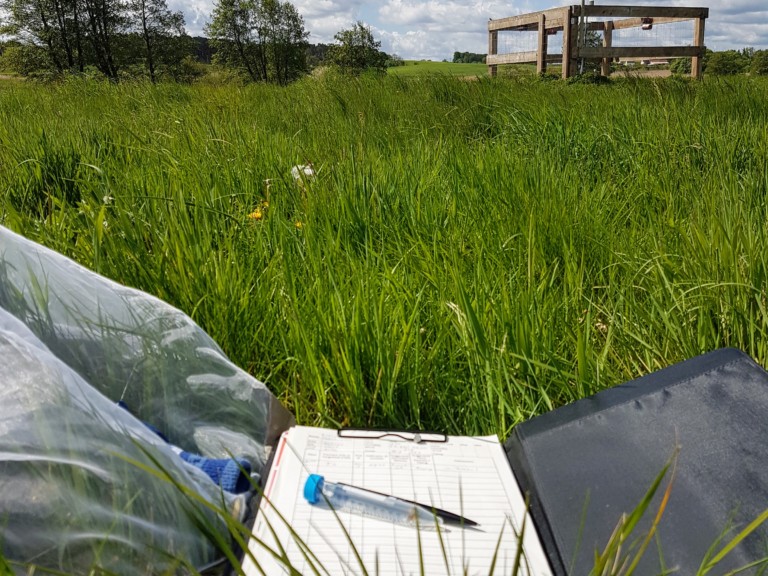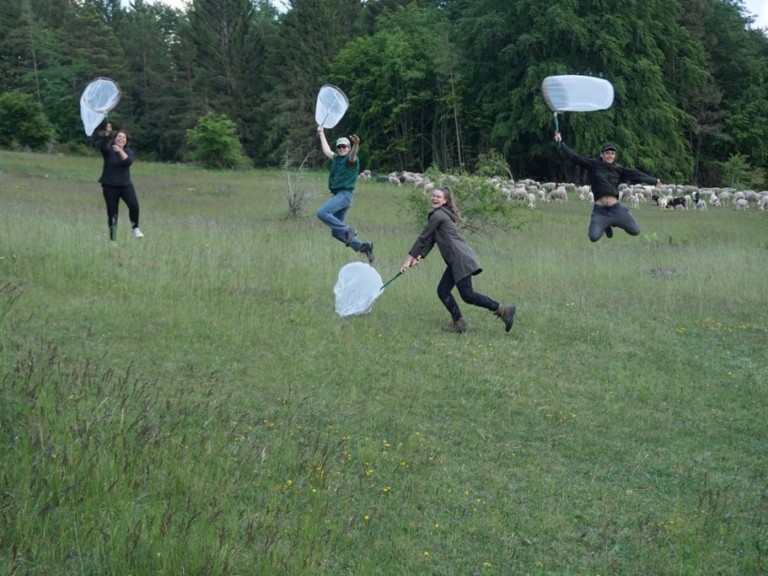#Animals #2023 – 2026 #2020 – 2023
NutriB2 (Cooperation project)
Nutrition as a critical link between biodiversity and bee health
The aim of the cooperation is to examine how the composition and diversity of food resources affect the nutritional status and health of wild bee species.

The aim is to understand how land-use-induced changes in the diversity and composition of flowering plants affect the interactions between plants and bees. Data will be collected on the following parameters:
- Diversity and abundance of wild bee species throughout the year
- Nutritional and health status of collected bee species in relation to the LUI
- Bee-flower interaction networks
- Chemical composition of pollen of bee-visited bee plant species
More information about this project can be found here: https://nutrib2.project.uj.edu.pl/
Parreño M. A., Werle S., Buydens L., Spitz J., Härtl F., Montoya J., Ruedenauer F., Arisoy B., Seiler R., Leroy C., Feng-Spitz Q., Nebauer C. A., Ferrari A., Proessl N., Borchardt R., Peters B., Siebler S., Reese M., Schumacher N., Phung T., Schildt K., Ebensberger J., Seiler M., Reiter P., Beelaert S., Buydens M., Koirala S., Moreniere J., Tänzler R., Alaux C., Filipiak M., Meeus I., Piot N., Kuhlmann M., Requier F., Klein A., Brunet J. L., Henry M., Keller A., Leonhardt S. D. (2025): Data on visitation records from wild bees and plants along a land use gradient in Germany and Belgium: laboratory work and protocol description for barcoding. Data in Brief 61, 111672. doi: 10.1016/j.dib.2025.111672.
More information:
doi.org
Parreno M. A., Werle S., Buydens L., Leroy C. , Roberts S., Koirala S., Filipiak M., Kuhlman M., Brunet J.-L., Henry M., Alaux C., Requier F., Piot N., Meeus I., Klein A.-M., Keller A., Leonhardt S. D. (2024): Landscape heterogeneity correlates with bee and pollen diversity while size and specialization degree explain species-specific responses of wild bees to the environment. Science of The Total Environment 954, 176595. doi: 10.1016/j.scitotenv.2024.176595
More information:
doi.org
Bare soil spots in grasslands in relation to wildbee richness and abundance
Nackte Bodenstellen im Grasland in Bezug auf Wildbienenreichtum und -reichtum
Härtl F. (2023): Bare soil spots in grasslands in relation to wildbee richness and abundance. Master thesis, TU München
Land-use intensity effects on intraspecific variation of pollination-associated floral traits in four typical grassland species
Auswirkungen der Landnutzungsintensität auf die intraspezifische Variation von bestäubungsassoziierten Blütenmerkmalen bei vier typischen Grünlandarten
Höwener A. S. (2022): Land-use intensity effects on intraspecific variation of pollination-associated floral traits in four typical grassland species. Master thesis, TU München
Parreño M.A., Alaux C., Brunet J.-L., Buydens L., Filipiak M., Henry M., Keller A., Klein A.-M., Kuhlmann M., Leroy C., Meeus I., Palmer-Young E., Piot N., Requier F., Ruedenauer F., Smagghe G., Stevenson P. C., Leonhardt S. D. (2022): Critical links between biodiversity and health in wild bee conservation. Trends in Ecology & Evolution 37 (4), 309-321. doi: 10.1016/j.tree.2021.11.013.
More information:
doi.org
Automatization Process of Landscape Heterogeneity Index for Biodiversity Exploratories
Automatisierungsprozess des Landschaftsheterogenitätsindex für Biodiversitätsexploratorien
Arisoy B. (2022): Automatization Process of Landscape Heterogeneity Index for Biodiversity Exploratories. Master thesis, TU München
Effects of Land-use Intensity on Pollen Diversity in Brood Cells of Osmia Bicornis A Light Microscopic Study of Pollen
Auswirkungen der Landnutzungsintensität auf Pollen Vielfalt in Brutzellen von Osmia Bicornis Eine lichtmikroskopische Untersuchung von Pollen
Seiler R. (2022): Effects of Land-use Intensity on Pollen Diversity in Brood Cells of Osmia Bicornis. Master thesis, TU München
Public Datasets
Werle, Susanne (2023): ITS2 DNA metabarcoding of wild bee pollen loads, collected in 2020 and 2021 across all three exploratories. Version 5. Biodiversity Exploratories Information System. Dataset. https://www.bexis.uni-jena.de/ddm/data/Showdata/31545?version=5
Parreno, Alejandra (2021): Visitation records of bees in Germany (57 plots) and Belgium (9 plots) in 2020 and 2021. Version 11. Biodiversity Exploratories Information System. Dataset. https://www.bexis.uni-jena.de/ddm/data/Showdata/31131?version=11
Non-public datasets
Land cover assessment of trees and grass 200 m around the centroid of plots with wild bee trap nests
Filipiak, Zuzanna (2025): Land cover assessment of trees and grass 200 m around the centroid of plots with wild bee trap nests. Version 2. Biodiversity Exploratories Information System. Dataset. https://www.bexis.uni-jena.de. Dataset ID= 32039
Stoichiometric composition of bees in wild bee trap nests
Filipiak, Michal (2025): Stoichiometric composition of bees in wild bee trap nests. Version 1. Biodiversity Exploratories Information System. Dataset. https://www.bexis.uni-jena.de. Dataset ID= 32040
Wild bee nest occupation and identification through barcoding 2020-2022
Werle, Susanne (2025): Wild bee nest occupation and identification through barcoding 2020-2022. Version 1. Biodiversity Exploratories Information System. Dataset. https://www.bexis.uni-jena.de. Dataset ID= 32041
Stoichiometry of pollen composition of wild bee nests
Filipiak, Michal (2025): Stoichiometry of pollen composition of wild bee nests. Version 2. Biodiversity Exploratories Information System. Dataset. https://www.bexis.uni-jena.de. Dataset ID= 32042
Pathogen content from bees
Buydens, Louella (2025): Pathogen content from bees. Version 1. Biodiversity Exploratories Information System. Dataset. https://www.bexis.uni-jena.de. Dataset ID= 32124
Traits of wild bees from the literature
Parreno, Alejandra (2024): Traits of wild bees from the literature. Version 1. Biodiversity Exploratories Information System. Dataset. https://www.bexis.uni-jena.de. Dataset ID= 31731
Land classification in an area of 500 m2 around plots based on remote sensing data
Parreno, Alejandra (2023): Land classification in an area of 500 m2 around plots based on remote sensing data. Version 4. Biodiversity Exploratories Information System. Dataset. https://www.bexis.uni-jena.de. Dataset ID= 31557
The interplay of landscape composition and configuration on social bee pollinators fitness
Requier, Fabrice (2023): The interplay of landscape composition and configuration on social bee pollinators fitness. Version 2. Biodiversity Exploratories Information System. Dataset. https://www.bexis.uni-jena.de. Dataset ID= 31555
Quadrant plant diversity 2021
Parreno, Alejandra (2023): Quadrant plant diversity 2021. Version 5. Biodiversity Exploratories Information System. Dataset. https://www.bexis.uni-jena.de. Dataset ID= 31556
Cooperations are projects financed by the cooperation partners’ own funds and thus financially independent of the DFG-funded infrastructure priority program ‟Biodiversity Exploratories (BE)”. They complement the BE with further interesting research content on biodiversity research and in return benefit from the infrastructure of the Biodiversity Exploratories.











